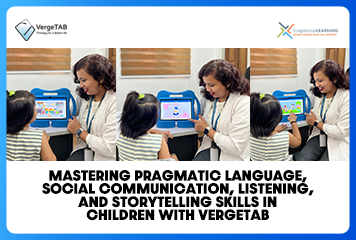Mastering Pragmatic Language, Social Communication, Listening, and Storytelling Skills in Children with VergeTAB
30 Sep 2025

Meet Anaya, an 8-year-old girl with a bright imagination and curious mind. She loves drawing, storytelling, and exploring ideas, but finds it hard to express herself clearly, follow routines, and interact confidently with peers.
This is a common dilemma faced by the parents of differently-abled children. Many parents notice their child can answer questions like “What’s your favourite colour?” However, they may struggle to tell a simple story, follow multi-step instructions, or join in with friends during play. These gaps can affect confidence, friendships, and learning.
As technology progresses, so does the solutions. In the current digital age, when everything from learning to shopping is shifting online, therapy also has unending possibilities, but you are right to question the other digital distractions that come with it. This is where VergeTAB comes in. Powered by XceptionalLearning (XL) platform, this Digital Therapy Activity Device is developed for exclusively for therapy needs. Unlike other tablets with distracting apps, VergeTAB provides structured, interactive activities that help children develop listening, pragmatic language, social communication, and storytelling skills in a fun and practical way.
In this article, we will be following Anaya’s journey to explore how children can strengthen key communication skills—like storytelling, social interaction, and language use—through VergeTAB, and how these skills translate into real-life situations.
Chapter 1: Listening – The Gateway to Understanding
Why Listening Matters: Listening is the first building block for communication. Children who listen effectively can follow instructions, understand social signals, and respond appropriately, which builds confidence and independence.
Scenario: Morning Chores
Anaya often forgot little things—like whether she had packed her pencil case or left her water bottle behind. Her mother would give three-step instructions like: “Pack your notebook, take your tiffin, and don’t forget your bottle.” But halfway through, Anaya would get distracted or mix things up.
What makes this hard for many kids like Anaya?
- Multi-step directions can be overwhelming
- Important parts are forgotten
- They rely a lot on reminders from adults
VergeTAB in Action:
With VergeTAB, Anaya started with simple listening games—like tapping a red apple when she heard it. Gradually, the steps got harder: “Tap the red apple, then the green balloon.” Because there are no distracting apps, she could focus better and build listening and memory skills, one step at a time.
Try This at Home or School
- At Home
- Use everyday routines (brushing teeth, packing bags) to give short, clear steps
- Repeat instructions together before starting
- In School
- Break tasks into steps
- Encourage the child to repeat steps out loud to help them remember
What Changed for Anaya?
Anaya strengthened her active listening, improved her working memory for multi-step instructions, and increased independence in daily routines. One day, after getting ready all on her own, she proudly said:“I did it all by myself!”
Chapter 2: Expanding Vocabulary Through Listening
Why Vocabulary Matters: Vocabulary is essential for expressing thoughts, understanding others, and engaging in meaningful conversation. A rich vocabulary improves comprehension, storytelling, and emotional expression.
Scenario: Mealtime and Story time
Anaya would say things like: “The soup… good… umm… hot.” She knew what she wanted to say—but didn’t always have the words.
What makes this hard for many kids like Anaya?
- Struggle to express thoughts clearly
- Difficulty understanding synonyms or context-based words
- Limited conversational depth
VergeTAB in Action:
On VergeTAB, Anaya starts by practicing word-to-picture matching: when she hears “giraffe,” she taps the giraffe image. The XL platform slowly introduces synonyms and categories: “Which is another word for happy?” → cheerful, glad, joyful. Gradually, VergeTAB moves to context-based listening: “The farmer put milk in a…?” (barn, bucket, river).
Try This at Home or School
- At Home
- Introduce new words naturally at meals: “This pasta is spicy. Can you think of another word for spicy?”
- Read stories and pause: “What does this word mean?”
- In School
- Encourage person-to-person word games
- Connect vocabulary to classroom objects or tasks
What Changed for Anaya?
Anaya expanded her vocabulary, improved comprehension and expression, and communicated more effectively with teammates. One day, after trying something new, she beamed and said: “I know another word for yummy—it’s delicious!”
Chapter 3: Pragmatic Language and Social Communication
Why Pragmatic Language Matters: Pragmatic language is how we use words socially—tone, timing, politeness, and turn-taking. It allows children to form friendships, participate in conversations, and navigate social settings successfully.
Scenario: Playground Interaction
Anaya could speak clearly, but playground time was tricky. She wanted to join in a game but didn’t know how to ask. She stood nearby, unsure, and missed her chance.
What Makes This Hard?
- Kids may talk well, but still struggle socially
- They may miss tone, body language, or speak out of turn
- It’s not just what they say—but how and when
How VergeTAB Helps
VergeTAB uses guided, real-life role-plays to help kids like Anaya:
- Anaya practices conversation role-plays, like ordering at a shop, where VergeTAB guides her responses and gently corrects missing polite words.
- She engages in group interaction simulations with animated characters, learning turn-taking and choosing relevant sentences confidently.
- The blank-tab + XL platform keeps her practice focused and distraction-free, reinforcing skills consistently for real-life application.
Try This at Home or School
- At Home
- Model polite requests and thank-yous
- Role-play playdate conversations
- In School
- Encourage turn-taking in group discussions
- Use “social scripts” for common interactions
What Changed for Anaya?
Anaya improved her pragmatic language, increased social confidence, and mastered better conversation flow. One day, she smiled and said:“I made a new friend today because I waited for my turn!”
Chapter 4: Storytelling Foundations
Why Storytelling Matters: Storytelling enhances imagination, sequencing, memory, and expressive language. It allows children to communicate experiences, entertain, and connect with peers.
Scenario: Show-and-Tell at School
During show-and-tell, Anaya stood up and said: “I went to the park. Played. Came home.” She knew what happened—but her story was short, choppy, and hard to follow.
Why This Is Tough for Many Kids
- Disorganized or short stories
- Limited use of descriptive vocabulary
- Trouble remembering story sequence
How VergeTAB Helps
Anaya starts with picture sequencing: three images (boy wakes up, brushes teeth, goes to school). She arranges them in order. VergeTAB then asks her to tell the story aloud: “First… then… finally…” Gradually, stories grow from 3 to 6 to 10 steps, improving her narrative structure.
Try This at Home or School
- At Home
- Bedtime stories: “What happened first? What came next?”
- Create simple photo albums for storytelling
- In School
- Encourage classmates to listen and ask questions
- Practice sequencing during classroom projects
What Changed for Anaya?
Anaya developed structured storytelling, enhanced vocabulary, and improved sequencing and expressive language. One day, after sharing confidently in class, she said: “I told the story without skipping a part!”
Chapter 5: Emotional Storytelling and Reflection
Why Emotional Expression Matters: Understanding and expressing emotions helps children develop empathy, connect with others, and reflect on their own experiences, leading to stronger relationships.
Scenario: Puppet Theatre at Home
During a puppet play, Anaya tried to act out a scene with a sad kitten. She paused and said: “The kitten… umm… cry?” She wasn’t sure how to describe what the kitten felt—or what to say next.
Why This Can Be Hard
- Difficulty expressing feelings
- Limited empathy for peers
- Trouble reflecting on personal experiences
How VergeTAB Helps
- VergeTAB shows scenes with emotions (child dropping ice cream, winning a race). Anaya labels feelings: sad, excited, and nervous.
- XL prompts: “What would you say if this happened to you?” → She practices empathetic responses.
- She also learns reflection: “How did you feel when your friend shared a toy?”
Try This at Home or School
- At Home
- Discuss daily events and feelings
- Introduce emotion vocabulary gradually
- In School
- Encourage peer discussions about feelings
- Model empathetic reflection
What Changed for Anaya?
Anaya gained empathy, emotional awareness, and the ability to reflect on personal experiences. With a big smile one day, she shared: “I can tell how others feel now!”
Chapter 6: Gamification, Home-to-School Transfer, and Daily Routines
Why Daily Routines and Transfer Matter: Skills must be practiced across environments to generalize learning. Consistent routines and gamified motivation help children retain and apply communication skills effectively.
Scenario: Daily Life Integration
Anaya enjoyed VergeTAB but needed to apply skills at home, school, and playdates. She sometimes forgot polite phrases or the sequence of steps outside the application.
Why This is Difficult
- Skills learned digitally may not generalize
- Children may lose motivation without rewards
- Routine practice is essential
How VergeTAB Helps
- Anaya earns stars and animations directly within the XL platform after completing tasks, keeping motivation tied to learning outcomes rather than unrelated videos.
- Custom activities aligned with school topics, like science facts or history stories, also reinforce daily routines such as morning tasks, hygiene, and scheduling, linking learning to real-life habits.
- Teachers track her progress through reports, and parents reinforce the same skills at home, ensuring consistent practice and smooth transfer between school and home environments.
Try This at Home or School
- Mini-Activities at Home
- Greetings Practice → “Hi,” “Good morning,” “See you tomorrow.”
- Two-Step Instructions → “Bring your shoes and close the door.”
- Storytime Sequencing → “What happened first in the story?”
- Emotion Reflection → “How did you feel when we visited Grandma?”
- Playdate Scripts → “Can I join you?” before playdates
- At School: Track progress; reinforce skills in classroom activities
What Changed for Anaya?
Anaya successfully transferred her skills across home, school, and social settings, built consistent confidence, and used polite, sequenced, and emotionally aware communication, joyfully stating, “I feel proud because everyone understands me now!”
Realistic Expectations: What VergeTAB Can Do vs. What Needs Guidance
Skills Fully Practiced on VergeTAB:
- Listening to multi-step instructions
- Word-to-picture matching and vocabulary exercises
- Role-play conversations for pragmatic language
- Story sequencing and oral narration
- Emotion labelling and reflection prompts
- Gamified progress tracking (stars, badges, animations)
Skills Requiring Adult Guidance for Generalization:
- Using polite phrases during real playground or classroom interactions
- Narrating personal stories to schoolmates or family
- Applying turn-taking and perspective-taking in group settings
- Practicing greetings, two-step instructions, and emotion reflection outside the app
Key Insight:
VergeTAB provides a structured, distraction-free foundation. Parents, teachers, and therapists are essential to bridge practice from the digital platform to everyday life, ensuring children like Anaya apply and retain skills confidently.
Conclusion: Anaya’s Journey to Confident Communication
Anaya’s story shows that progress in communication is not about quick fixes but about small, meaningful steps practiced daily. With VergeTAB, she learned to listen carefully, follow instructions independently, join conversations with confidence, and transform her imagination into structured stories. Most importantly, she discovered how to reflect on her feelings and adapt her communication for different situations.
For parents, therapists, and educators, the message is clear: children need consistent opportunities to practice, reflect, and express. VergeTAB provides the structured foundation, while family, teachers, and therapists bring those skills to life. Together, they create a learning circle where children like Anaya don’t just practice words — they discover the joy of being understood, included, and celebrated.
If you want your child to experience similar growth, contact us to learn more about our Interactive learning device for children, designed to develop listening, social communication, storytelling, and emotional skills in a structured, engaging way.


